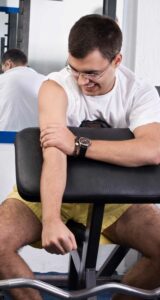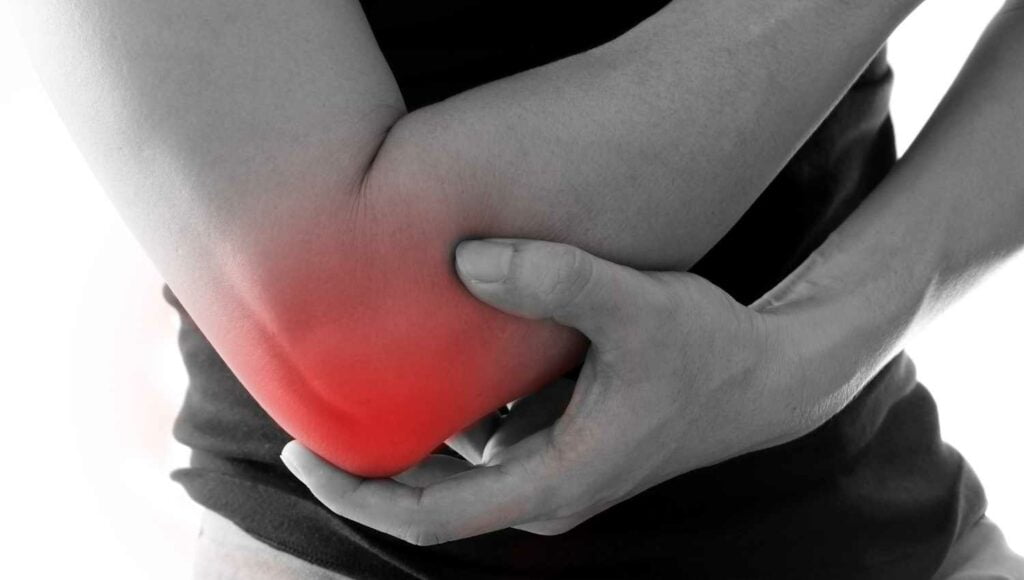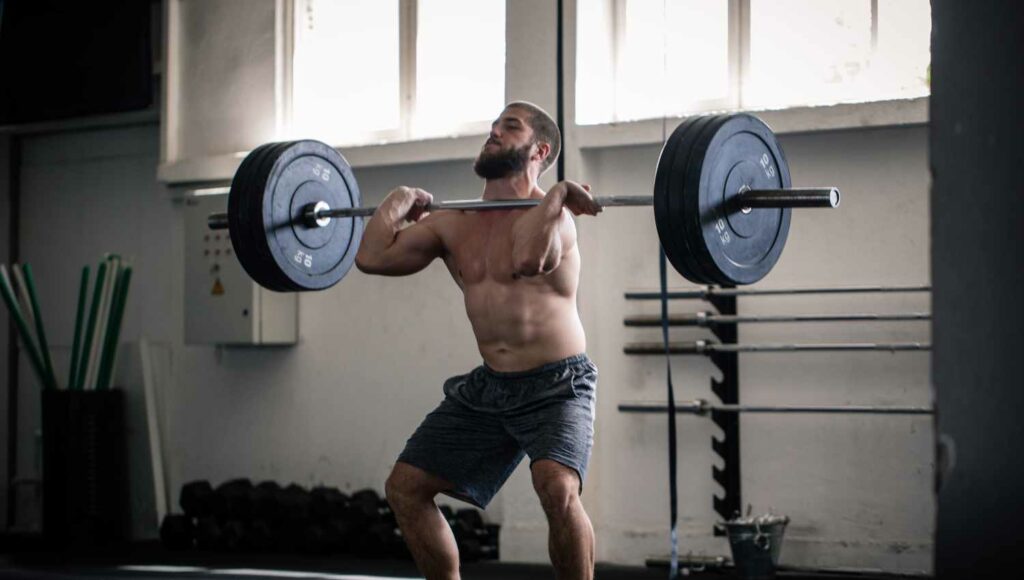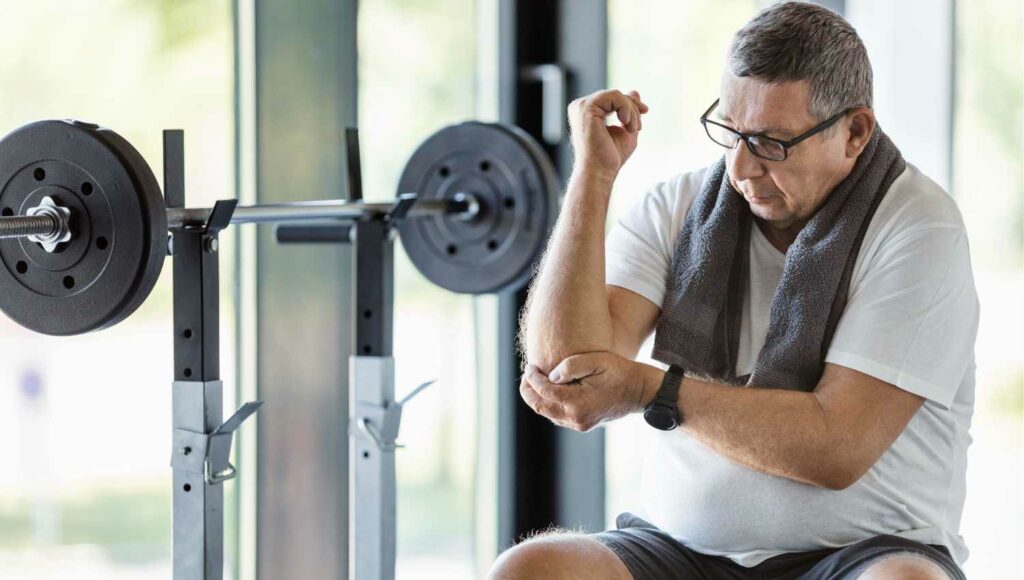Pushing through an intense workout, you feel that familiar burn in your muscles signaling progress. Yet, amidst the adrenaline, there’s a different sensation creeping in – a nagging pain in your elbow while lifting weights. It’s a pain that, if ignored, can turn your fitness journey into a painful ordeal. You’re not alone; many avid weightlifters grapple with elbow pain, often sidelining their ambitions. But the good news? You don’t have to let elbow pain hijack your fitness goals. Dive in, as we uncover the causes of elbow pain from lifting and, more importantly, the strategies to alleviate it and get you back on track. So, let’s get started!
Contents
Understanding Weightlifting-Induced Elbow Pain
 Lifting weights is an intricate dance of muscles, tendons, and joints working in harmony. When done correctly, it’s a symphony of movements that can lead to increased strength and muscle tone. But one wrong move or overexertion, and the harmony is disrupted, often manifesting as pain in vulnerable areas like the elbow.
Lifting weights is an intricate dance of muscles, tendons, and joints working in harmony. When done correctly, it’s a symphony of movements that can lead to increased strength and muscle tone. But one wrong move or overexertion, and the harmony is disrupted, often manifesting as pain in vulnerable areas like the elbow.
The elbow, a hinge joint formed by the union of the humerus, radius, and ulna, is surrounded by a myriad of muscles, tendons, and ligaments. These structures allow us to flex, extend, and rotate our forearms with ease. In weightlifting, exercises such as bicep curls, tricep extensions, or even the bench press exert significant force on these structures.
Certain movements, especially if done with improper form, can strain the tendons that anchor muscles to the elbow bones. Over time, repeated stress without adequate recovery can lead to microtears, inflammation, and eventually conditions like tendinitis.
In essence, while weightlifting is beneficial for overall strength and conditioning, it’s imperative to understand its impact on the elbow’s anatomy. This knowledge helps in pinpointing the root cause of pain and in making informed choices about exercise regimens.
What Causes Pain in the Elbow From Lifting Weights?

Lifting weights can be a fulfilling activity that empowers many to achieve their fitness goals. However, certain factors and conditions can make this endeavor less enjoyable, especially when accompanied by nagging elbow pain while lifting weights. Here, we’ll explore the root causes, both related directly to weightlifting and those that can be exacerbated by it.
Tendinitis
One of the most common causes of elbow pain among weightlifters is tendinitis. This is an inflammation of the tendons, which are the thick cords attaching your forearm muscles to the bone. Overexerting these tendons or not giving them enough time to recover can lead to painful inflammation.
Elbow Strains or Sprains
These are injuries to the muscles (strains) or ligaments (sprains). Lifting weights that are too heavy or using improper form can strain or sprain the structures around the elbow.
Tennis Elbow (Lateral Epicondylitis)
Despite its name, tennis elbow is not limited to tennis players. It’s a condition where the outer part of the elbow becomes painful due to the tendons being overworked. Repetitive movements, like lifting weights, can exacerbate this condition.
Golfer’s Elbow (Medial Epicondylitis)
Similar to tennis elbow but affecting the tendons on the inside of the elbow, this condition can arise from repetitive flexing, gripping, or swinging motions common in some weightlifting exercises.
Arthritis
Weightlifting can sometimes aggravate arthritis symptoms in those predisposed to the condition. Regular lifting can exacerbate the pain, especially if not performed with proper form or if the weights are too heavy.
Bursitis
Overuse or repetitive movements during weightlifting can lead to inflammation of the bursa, a fluid-filled sac that cushions the elbow joint.
Additionally, here are the causes, both related directly to weightlifting and those that can be exacerbated by it.
- Poor Weightlifting Form
Incorrect form while exercising can place undue strain on the elbow’s muscles and tendons. This misalignment can lead to acute or prolonged pain and even long-term complications. - Overtraining
Training relentlessly without allowing adequate recovery time can culminate in overuse injuries, with inflammation and pain in the elbow being common outcomes. - Muscle Imbalances
Muscle groups that are disproportionately stronger than their counterparts can place added tension on the elbow, resulting in pain. - Lifting Too Heavy, Too Soon
Rapidly increasing the weight you’re lifting without proper conditioning can put an unexpected load on tendons and ligaments, leading to strains or tears around the elbow. - Ignoring Pain and Continuing to Lift
Pursuing workouts despite initial discomfort or pain can exacerbate the problem, causing further injury and delaying recovery.
Recognizing and understanding these causes can guide more informed decisions in your weightlifting regimen. This proactive approach can help mitigate potential risks and ensure that you’re safeguarding your elbow from pain while lifting weights.
The Role of Proper Form and Technique

Maintaining proper form and technique during weightlifting is not just about optimizing results—it’s also essential for injury prevention, especially in delicate areas like the elbow. Here’s why the correct form is paramount:
- Injury Prevention: Proper technique ensures that the weight’s strain is evenly distributed, minimizing the risk of strains, sprains, or tears.
- Effective Targeting: When you use the correct form, you target the intended muscle group effectively, avoiding overcompensation by other muscles, which can put extra stress on the elbow.
- Consistent Progress: Correct form leads to consistent and effective muscle engagement, which in turn results in more balanced and steady growth.
- Improved Joint Health: Proper technique ensures that the joints, including the elbow, move within their natural range of motion, reducing wear and tear.
- Better Workout Efficiency: When each rep is done correctly, you get more out of your workout in less time, reducing prolonged strain on the elbows.
- Reduced Risk of Chronic Issues: Habitually using poor form can lead to long-term problems, not just in the elbow but in other parts of the body as well.
- Increased Workout Longevity: By avoiding injury through proper form, you can ensure that you’re able to keep working out consistently and effectively for years to come.
Prioritizing form and technique is an investment in your long-term health and fitness. It’s always better to lift lighter with the right form than to lift heavier and risk injury.
Therapeutic Approaches for Persistent Pain
 When the elbow pain resulting from weightlifting refuses to fade away, it’s essential to take proactive measures. Ignoring persistent pain can lead to long-term complications and hinder your progress. Here are some therapeutic approaches that can offer relief:
When the elbow pain resulting from weightlifting refuses to fade away, it’s essential to take proactive measures. Ignoring persistent pain can lead to long-term complications and hinder your progress. Here are some therapeutic approaches that can offer relief:
- Physiotherapy: A trained physiotherapist can assess the nature of your elbow pain and recommend tailored exercises to strengthen the muscles around the elbow, improve flexibility, and enhance joint health.
- Massage Therapy: This can be beneficial in easing muscle tension, improving circulation, and facilitating faster recovery. Regular massage sessions focusing on the arm muscles and tendons can relieve pain and prevent it from recurring.
- Over-the-Counter Pain Relievers: Non-prescription medications, such as ibuprofen or naproxen, can help reduce inflammation and provide temporary relief from pain. However, they should be used judiciously and always as per the recommended dosage.
- Cold Compress: Applying ice or a cold pack to the affected area can help reduce inflammation and numb the area, offering immediate relief. It’s especially beneficial after a strenuous workout.
- Compression: Wearing an elbow brace or compression sleeve can provide support, reduce swelling, and alleviate pain. It can also remind you to be cautious when using the joint.
- Elevation: Keeping the elbow elevated can reduce swelling, especially if there’s any associated injury.
- Joint Mobilization Techniques: Performed by trained therapists, these techniques can improve the range of motion and alleviate pain.
- Electrotherapy: Modalities like TENS (Transcutaneous Electrical Nerve Stimulation) units can be used to manage pain effectively.
If these approaches don’t bring relief or if the pain worsens, it’s crucial to seek medical advice. An orthopedic specialist or sports medicine doctor can provide a comprehensive evaluation and more advanced treatment options.
Knowing When to Consult a Professional
- Persistent pain that lasts more than a week despite rest and home remedies.
- Sharp, stabbing pains that occur even when not lifting weights.
- Swelling or significant bruising around the elbow joint.
- Difficulty in straightening or bending the arm.
- Elbow pain that disrupts sleep.
- Symptoms of nerve involvement such as tingling, numbness, or weakness in the hand or fingers.
- Previous history of elbow injury and recurrence of pain.
- Signs of infection, including warmth, redness, or a fever.
- Pain that is affecting daily activities or overall quality of life.
Conclusion
Lifting weights can be immensely beneficial for building strength and enhancing physical fitness. However, like all physical activities, it comes with its set of challenges, and elbow pain is a common issue many weightlifters face. Addressing the problem at its roots, understanding the causes, and following correct techniques can significantly reduce the risk. Yet, if the pain persists, it’s essential not to ignore it. Remember, your health and well-being come first. If you’re experiencing Elbow pain, physical therapy for elbow pain at PhysioMantra can help: Book an online physical therapy session.



